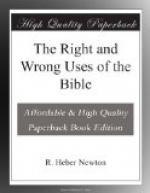“Whose voice then shook the earth: but now he hath promised, saying, yet once more I shake not the earth only, but also heaven. And this word, Yet once more, signifieth the removing of those things that are shaken, as of things that have been made, that those things which cannot be shaken may remain.”
According to its root-meaning, “learning” is a “shaking.” Every new learning shakes society, now as in the days past. As the writer of the Epistle to the Hebrews saw, it is God who is shaking society in every such new learning, to the end that “those things which cannot be shaken may remain.” Man need not fear to follow in the steps of God.
There is danger now in shaking men’s faiths. There is danger, too, in leaving men’s faith unshaken—unless the Divine process of progress is wrong. In the stress and storm of the tossing sea, Faith may go down in the waters. It may also die of dry rot by the old wharves. There is danger in rash utterance, but there is at least equal danger in timid silence. The time never comes when a reconstruction does not imperil some great interest. None the less the reconstruction must go on. Delay in pulling down may make building up of the old structure impossible.
As the story of past civilizations sadly shows, the gulf between the popular superstitions and the thoughts of scholars may widen until no bridge can span it, and religion perishes in it. It seems to me that the time has come when the pulpit must keep no longer silence. Its silence will not seal the lips of other teachers. Books and papers are everywhere forcing the issue upon our generation. Men’s minds are torn asunder, their souls are in the strife. It behoves the Churches to remember that great word of Luther:
“It is never safe to do anything against the truth!”
When the venerable cathedral, in which our forefathers sought God and found Him, grows dangerously unsound; when its columns have crumbled and its arches have sprung, and its stout oaken timbers have dried into dust; the guardians of the sacred pile must plan its restoration as best they can. They must shore up its treacherous walls, take out its dead materials, carve new heads for the saints in the niches of the doors, build up the edifice anew, following faithfully as may be the old lines, and striving for the old spirit. When the scaffolding comes down, we may feel a shock of pain at the strange raw look of that which Time had stained with sacredness. But the minster has been saved for our children; and, when they shall gather within its historic walls, those walls will have grown venerable again with age, and they will not feel the loss which we have suffered, while as of old, they, too, shall hear the voice of God and find His Holy Presence.
I propose to consider with you, carefully but frankly, the real nature and the true uses of the Bible.
* * * * *




